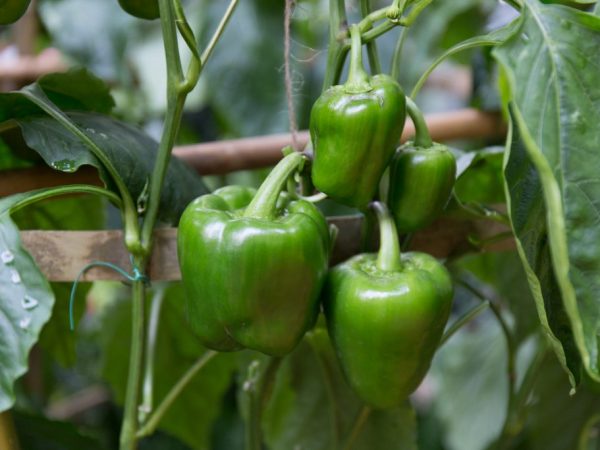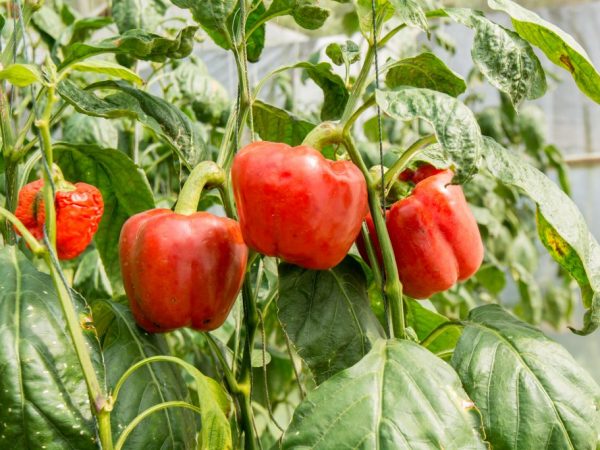Pepper growing rules
Growing pepper is troublesome. However, using little secrets, it is possible to grow delicious peppers in the open field and in a greenhouse. Consider the basic rules of agricultural technology and tips for growing.

Pepper growing rules
General recommendations
Pepper is a lazy vegetable crop. Those wishing to grow peppers need to adhere to the cultivation technology:
- The vegetable is sensitive to the temperature regime of the air and soil. Sprouted seedlings are transplanted with sweet peppers only at a temperature of at least 14 ° C, choosing a place protected from the wind.
- Watering peppers requires abundant, but infrequent. The soil in which vegetables are grown should not be dry or too wet: this affects the quality of flowering and leads to the fall of flowers and foliage.
- Lack of light affects the process of growth and flowering of the plant, which subsequently affects the yield of the vegetable crop.
- To increase the yield of a vegetable, mulching allows mulching, in which organic matter and protection with a covering material are more often used. We must not forget about hilling bushes.
- Pepper is not recommended to be planted on the same bed for 3 seasons in a row. Adhering to crop rotation, you can not use drugs against plant diseases and pests. A correctly planted pepper is quite stable.
- With insufficient quality pollination of flowers, especially when growing peppers on a balcony, on a window or in a greenhouse, crooked vegetables of an irregular shape appear. This can be avoided by periodically shaking the plants during the flowering stage. Also, do not plant different varieties next to each other, you need to separate the sweet from the bitter so that the plants do not become dusty among themselves.
Without making mistakes in cultivation, it is easy to get a good harvest of salad vegetables.
Selection of varieties
The correct cultivation of peppers involves the selection of a variety.
Seeds
Today there are varieties and hybrids f1. Their difference is that there is no point in collecting seeds from hybrid vegetables, since they do not transmit the characteristics of the parent species during reproduction. Seeds of hybrids have to be purchased annually, but they show high yields with large fruits, are more resistant to diseases, and show themselves well when grown in hydroponics.
Unlike hybrids, varietal species can be grown not only for the purpose of obtaining vegetables for consumption, but also for further collection of seeds used as seed in a new gardening year.
Ripening terms
Gardeners grow peppers, while planting varieties with different ripening periods to ensure continuous harvesting, since the vegetable crop does not have a good technological keeping quality.
In warm areas, almost all varietal varieties are grown by seedlings or using a non-seedling method.
However, it is impossible to plant and grow late-ripening sweet Bulgarian or black and red hot peppers in the northern regions in the open field in a summer cottage. For such areas, it is recommended to choose early ripening peppers for planting, which fully ripen in a short period of time and plant them in a greenhouse. In the northern regions, it is advisable to plant peppers with seeds so that the vegetables have time to ripen before the first frost.
When choosing a pepper variety for growing, you can focus on the ripening time table:
| Varieties | Ripening terms |
| Early (Tusk, Eroshka, Ivanhoe, Five-color) | 80-100 days |
| Mid-season (Cherry, purple Othello, Phoenix) | 115-130 days |
| Late Rages (Gladiator, Black Cardinal) | 140 days |
Soil and seed preparation
The success of the future harvest depends on properly prepared soil and high-quality seeds.
Soil soil
For growing peppers, it is recommended to prepare fertile soil. The acidity level should not be high (in the range from 6.2 to 7.0 pH points), however, the vegetable crop can also grow on alkaline soil, so the upper limit of the acidity level may be slightly higher.
To bring the acidity level to the required level, additives allow:
- with excess acid, ash powder is added to the soil or limestone is mixed with it,
- with an excess of alkali, needles are mixed into the soil or peat moss is mixed.
The soil is examined for lumps and stones, removing large ones.
For seedlings, fertile black soil is used, which is diluted in equal parts with river sand. By mixing a little vermiculite with it, you can provide the necessary moisture and looseness of the soil for sowing in a summer cottage or at home.
Seeds
If you soak the seeds in water for 2-8 hours before sowing until they sink to the bottom, you can speed up the germination process by softening the cover. Also, for the purpose of disinfection, the seed material is soaked in low concentration chamomile tea or in a solution with hydrogen peroxide at the rate of 2 tsp. in a glass of water.
Growing seedlings
The prepared soil is filled with containers where the seedlings will grow. As such a container, simple store plastic containers are suitable, in the bottom of which holes must be made. Drainage is poured onto the bottom of the container: pebbles or small stones - and only then the soil mixture.
Sowing
The seeds are sown at a distance of 1.5 to 2 cm in pre-cut grooves spilled with warm water. Sprinkle the sown seeds with the same soil mixture, sprinkle the ground abundantly with water from a spray bottle on top. The container with the planted seeds is covered with foil.
The temperature for growing seedlings is from 24 ° С to 26 ° С.
To speed up the process of seed germination, you can put a container with sowing under a light lamp with a power of 40-80 watts. Additional lighting is especially required when there is not enough sunlight in an enclosed space. The lamp is placed at a distance of 8-10 cm from the surface of the soil mixture.
Hardening
With the first seedlings, which appear after 5-6 days, the seedlings are placed in a cooler place, lowering the degree of the environment to 14-16 ° C. At first, this is done for several hours a day, gradually increasing the amount of residence time. This allows you to strengthen the root system of the plant and harden young seedlings. after a week of hardening, the temperature degree begins to gradually rise to a level of 23-25 ° C.
Transplanting seedlings and care
2 pairs of leaves grown in young seedlings are a sign of the readiness of pepper seedlings for transplantation to a permanent growing site.
If you plan to continue growing peppers at home, each bush can be transplanted into a separate container. Most often, small shrub peppers are grown at home in pots, hanging baskets, plastic bottles or buckets. When transplanting seedlings into open soil, a distance of 25-40 cm between the bushes is maintained.
Watering
The main care for pepper, sweet or red bitter, involves regular watering, the first time it is carried out immediately after transplanting the seedlings to its permanent place. The second irrigation procedure is carried out after 4-5 days.
The regularity of watering in open soil also depends on the weather conditions. On hot and dry days, watering the peppers is required every 7 days. This frequency is adhered to until the formation of ovaries. Bushes stop watering at the stage of active fruiting.
Mineral nutrition
If mineral nutrition is not required at the stage of growing seedlings of peppers, fertilizer is applied for the transplanted plant at least 3 times. The first groundbait is carried out 2 weeks after the plant is transplanted to a permanent growing site. Secondary fertilization is applied at the stage of fruit formation. The third groundbait is made after 2-3 weeks after the second.
Peppers respond favorably to foliar nutrition in the form of spraying.
Growing in different conditions

Growing possible in a greenhouse and in the open field
Depending on where you intend to grow a vegetable crop, you need to adhere to the cultivation rules.
Home conditions
You can grow a good sweet or hot pepper in the following way: sow seeds in small containers, covering them with film or glass on top. After 5-7 days, when the first shoots appear, the seedlings are dived into separate pots. Further care comes down to timely watering and the introduction of mineral nutrition.
For the cultivation of hot and decorative varieties of pepper, a window sill is often adapted. Harvesting can be done all year round.
To create proper lighting for home growing of peppers, screens with a reflective surface are often used. They are placed from the side of the room. In the dark winter time phytolamps help to provide light. When it is not possible to create additional artificial lighting, it is recommended to plant seeds no earlier than the last days of February-early March, when daylight hours increase.
Greenhouse conditions
Growing sweet bell peppers and hot peppers in a greenhouse is the most viable option. Features of such a cultivation of a vegetable crop and care for it:
- correct watering, carried out in the morning with water heated to 18-20 ° С,
- regular ventilation of the greenhouse,
- maintaining soil temperature at the level of 18-22 ° С, air temperature - at least 25 ° С,
- additional lighting,
- introduction of nitrogen-containing complexes at the stage of active growth, fertilization with superphosphate at the stage of budding and fertilizing with mineral compositions during the formation of ovaries and the appearance of fruits.
In the open field
It is possible to grow pepper in the garden if you protect the plantings from temperature extremes using a covering non-woven film material of black color. Sprouted seedlings are planted, depending on the region, but in any case, when all frosts end.
The largest, largest and healthiest vegetables grow in a sunny area.
In order to protect plantings on unprotected ground, gardeners use little tricks: against the winds, they plant a live flap in the form of corn, tall flowers and other plants that exceed the size of pepper bushes from the north side.

